|
Choosing Bakeware Is More Than Cookies, Cakes and PiesWhen choosing bakeware we normally think of choosing cooking containers for baking cookies, cakes and pies, but bakeware is used for cooking casseroles as well. Just as when choosing cookware, choosing bakeware has many considerations. Some basic considerations are: 1. Choosing the correct size for the item being baked When choosing bakeware there are many styles, sizes and materials to choose from. There are however some basic bakeware items that are key to any kitchen. As starter items bakeware that should be on hand are:
10 x 15 inches to 12 x 18 inches baking sheet Other Add On Bakeware Baking sheets of different sizes (generally used for cookies and breads) Just as when choosing cookware there are various materials choices when choosing bakeware, and it pays to buy quality right from the start. Materials Choices Aluminum Although aluminum is a good heat conductor and heats up quickly and evenly; however due to the light weight material pans constructed of aluminum may warp under high heat and may corrode over time, as a result aluminum that has been coated or anodized may work best. Cast Iron Cast iron is a very heavy material that heats up slowly and may not be a good choice for some baking tasks, but for a dish that requires a long cooking time, cast iron may work well. Ceramic Ceramics work well for casseroles and due to its ovenproof nature can go from oven to serving to refrigerator for food storage. Glass Bakeware made of tempered glass conducts heat well and is excellent for pies, lasagna, casseroles and brownies, and can be placed in the dishwasher for easy cleaning. Nonstick Nonstick bakeware can save time since the nonstick coating makes removing baked items easier and is easier to clean; however nonstick coated with traditional materials wear off over time and metal utensils can’t be used with nonstick since metal will scratch the nonstick coating and cause it to deteriorate quicker, newer materials such as Thermalon which is a ceramic based material make nonstick surfaces more durable and conduct heat better for baking than traditional nonstick materials.
Silicone Silicone is a marvelous new invention that is lightweight and flexible, you would almost believe that you can’t cook in anything that has a much give as silicone bakeware, but it works well for those baking pieces that it is currently available for such as muffin pans, cake pans, and bread pans. Baked items are easy to remove because of its nonstick properties, and are easy to clean. Silicone also tolerates heat well up to 675 degrees Fahrenheit. Stainless Steel Stainless steel is the fan favorite for bakeware since most recipes are designed with cooking times and temperatures of stainless steel in mind. Stainless steel pans do however require oiling before use since materials do stick to stainless steel and can be difficult to remove if the pan hasn’t been previously oiled. Stainless can be difficult to clean if not previously oiled, but does resist rust and corrosion.
For some great sections on choosing bakeware some great references are: • The Taste of Home Cookbook – All New Edition from Taste of Home Books, Reiman Media Group • The All New Good Housekeeping Cook Book, Edited by Susan Westmoreland, Hearst Books, New York • Betty Crocker Cookbook – New Edition, by Wiley Publishing, Inc. • The Food Encyclopedia by Jacques L. Rolland and Carol Sherman with other contributors • The Complete America’s Test Kitchen TV Show Cookbook 2001-2010 by The Editors of America’s Test Kitchen
Cooking Basics
|
Bakeware Variety
Aluminum Nonstick
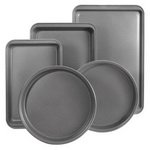
Ceramic Bakeware
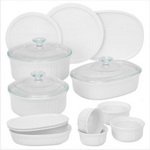
Glass Bakeware

Nonstick Bakeware
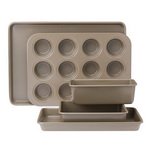
Silicone Bakeware
![]()
Stainless Steel Bakeware
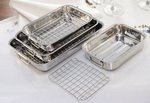
Individual Choices
4.8 Qt Glass Baking Dish

10 inch Bundt Pan

10 inch Springform Pan
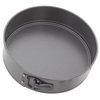
12 Cup Muffin Pan

13x9 Inch Baking Pan

17inch Jellyroll Pan

30x30cm Baking Sheet

Ramekins






